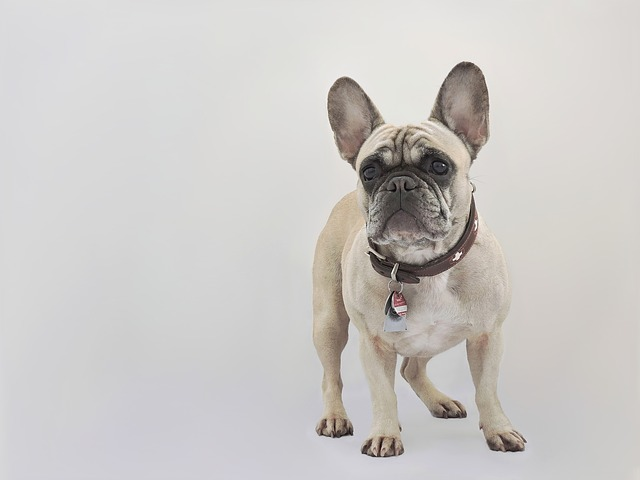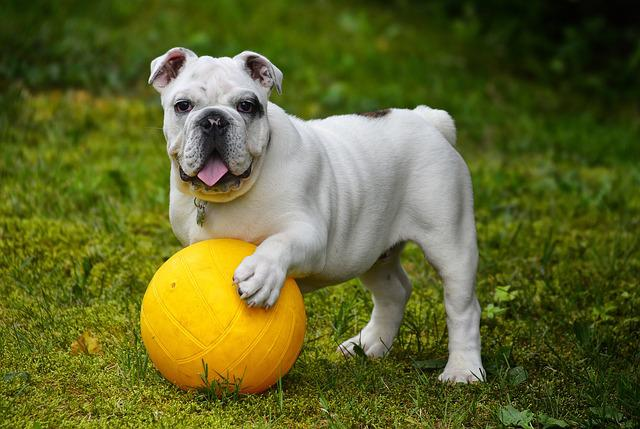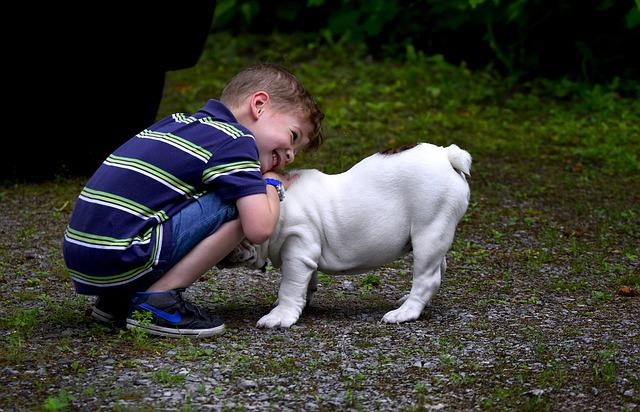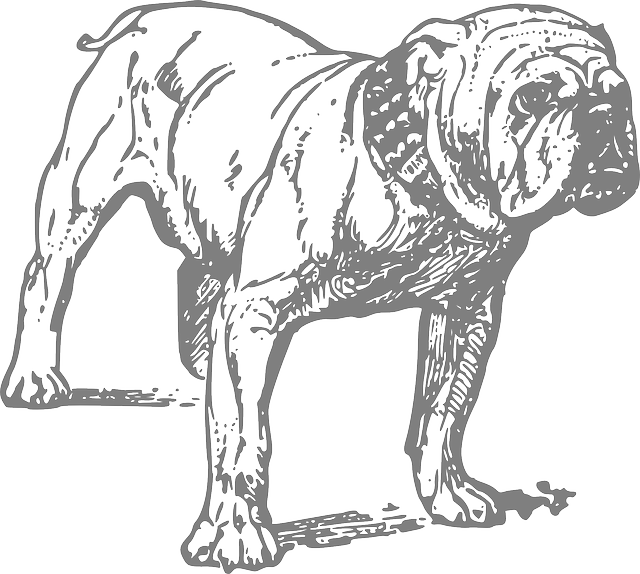The Bulldog is a very popular breed of dog. According to the American Kennel Club, they are the fourth most popular breed of dog in the United States. Bulldogs are known for their wrinkled face and stocky build.

They are considered to be a friendly and gentle breed, but they can also be quite stubborn.
There are six types of bulldogs:
- American Bulldog
- French Bulldog
- English Bulldog
- Australian Bulldog
- Victorian Bulldog
- Bullmastiff
Before we take a deeper dive into each of the six types of bulldogs, let’s take a look at the breed history.
Bulldog history

Bulldogs originated in England in the 1600s as fighting dogs. They were used in a sport called bull-baiting, where they would fight a bull until it was injured or killed.
In bull baiting, a Bulldog would attack a chained bull. The Bulldog’s stocky build and muscular body allowed it to hang onto the Bull’s face, even when the Bull shook its head.
Bull baiting was outlawed in England in 1835, but by that time the Bulldog had become a popular pet.
Bulldogs were brought to the United States in the 1800s and have been one of the country’s most popular breeds ever since.
The Bulldog is a member of the Molosser family of dogs, which includes other stocky breeds such as the Boxer and Mastiff. Bulldogs are descendants of the Old English Bullenbeisser, a now extinct dog breed.

Bulldog breed characteristics
Bulldog breeds are muscular dogs with short snouts with a gentle and calm demeanor.
Bulldog breeds come in a variety of colors, including white, brindle, fawn, and piebald. Bulldog breeders typically select for a wide range of coat colors in order to produce healthy puppies with good conformation.
Bulldogs are friendly dogs that are good with children. They generally get along with other dogs and are a calm breed that does not require a lot of exercise. They make good pets for people who live in apartments or small homes.
Breed overview
Bullys have a reputation for being aggressive, but this is not true of all bulldogs. Some are very gentle and loving dogs.
It’s important to note that not every type of Bulldog are well known breeds, and even the English Bulldog and Australian varieties are not listed on the official list of all American Kennel Club dog breeds. However, it is noted that the American Bulldog is believed to be a descendant of English Bulldogs.
— Health and nutrition overview
They are known for being loyal and affectionate dogs. Bulldogs can make great family pets, but they do require some special care. Bulldogs are susceptible to a number of health problems, so it is important to make sure they are getting the proper exercise and nutrition. Bulldogs also tend to snore and drool, so you will need to be prepared for that if you decide to adopt one!
Differences between Bulldogs
One of the key things you will note when looking for the differences between the various bully breeds is how each dog breed was originally utilized. Most bulldogs were used to help on the farm.
The breed standard build and appearance of each dog is the about the same. You will notice the same breed characteristics from the original English Bulldogs, a bulldog‘s face that is wrinkled, chest that is thick, and legs that are stocky.
Also, as shared earlier, the English Bulldog was actually used for deadly dog sports.
American Bulldog
American Bulldogs were originally bred for farm work. They are now popular as family pets. Bulldog breeds are known for their stocky build, characteristic ” Bulldog face “, and a gentle temperament. American Bulldogs have a life expectancy of 10 to 12 years.
— American Bulldog weight and height and chest
The American Bulldog typically stands about 18-21 inches tall and weighs around 65-85 pounds. They have a very broad chest and strong jaws.

French Bulldog
Frenchies are known for their bat ears, short muzzles and large expressive eyes. They are considered to be one of the best breeds for people with allergies because they do not shed hair. The life expectancy of French Bulldogs is usually 10-12 years, but some have lived as long as 14 years.
— French Bulldog weight and height and chest
The Frenchie Bulldog breed is a French Bulldog/Bulldog mix. They can be categorized as small dogs to medium sized dogs, weighing in at about 28-38 pounds and standing about 12-15 inches tall at the shoulder. They have a wide chest and sturdy build.

English Bulldog
The English Bulldog is a breed of dog that is noted for its unique appearance. They are stocky dogs with a wide head and a protruding lower jaw. They come in a variety of colors, including black, white, fawn, and brindle. The average lifespan of an English Bulldog is 8-10 years.
— English Bulldog weight and height and chest
Measurements for English Bulldogs typically are around the same weight as standard bullys – around 50-55 pounds and stand about 12-13 inches tall at the shoulder. They have a broad chest and a short, thick neck.
— Olde English Bulldogge
An Olde English Bulldogge is a Bulldog breed that is considered to be a descendant of the original Bulldog. They are known for their large, blocky heads and muscular build.
Victorian Bulldog
The Victorian Bully is a rare breed that was thought to have died out after World War II. However, a few enthusiasts kept the breed alive and it is now enjoying a resurgence in popularity.
The Victorian is a medium-sized dog with a wrinkled face and short, stubby legs. They are muscular and robust, and make excellent guard dogs. They are known for their friendly personality and good temperament. The life expectancy of Victorians is about 8-10 years.
— Victorian Bulldog weight and height and chest
Bulldog weight and height and chest – Bulldog breed information states that the average weight of a Bulldog is 40 to 50 pounds and the average height is 12 to 16 inches. The Bulldog’s chest should be wide and deep.
Australian Bulldog
The Australian Bulldog is a Bulldog breed that was specifically bred in Australia. They are known for their friendly and outgoing personalities, as well as their muscular builds.
The life expectancy of Australian Bulldogs is about 10 to 12 years. They are a sturdy breed that is relatively healthy, but like all breeds, they are prone to certain health problems. Some of the health conditions that can affect Bulldogs include hip dysplasia, elbow dysplasia, heart disease, and Bulldog encephalitis.
— Australian Bulldog weight and height and chest
The Australian Bulldog typically weighs in at around 66-88 pounds and stands at 16-20 inches tall. They have a chest circumference of around 38-44 inches.
Bullmastiff
Bullmastiffs are a large breed of dog originally bred in England for the purpose of guarding estates. They are a mix of Bulldog and Mastiff, and are known for their strength, size, and courage.
Bullmastiffs make excellent family pets and are known for being gentle and good with children. They require a lot of exercise, and because of their size, should not be kept in an apartment.
Bullmastiff health
The Bullmastiff life expectancy is around 8-10 years. They are a healthy breed, but like all dogs, they can be prone to certain health problems. Some common health problems seen in Bullmastiffs include hip dysplasia, elbow dysplasia, and cancer. Bullmastiffs should be groomed regularly, and their nails should be trimmed every few weeks.
Bullmastiff Bulldog weight and height and chest
Bullmastiffs typically weigh in around 100-130 pounds and stand about 24-27 inches tall at the shoulder. They have a broad chest that is about 50% of their height.
Bulldog club insight
If you are in search of a bulldog, ideally, you will be able to adopt one. However, it that is not possible, you should reach out to a local breed club or bulldog club (e.g., Bulldog Club of America) for insight about available bulldogs in your area.
Use your local Bulldog Club is a great resource
A Bulldog Club is a group of Bulldog lovers who get together to celebrate their favorite breed of dog. They typically meet once a month to share stories, pictures, and news about Bulldogs.
They also often organize events like Bulldog picnics and walks where Bulldog owners can come together and socialize with other Bulldog enthusiasts.

Bulldogs types
Today, Bulldogs are available in two main types: Standard Bulldog and Miniature Bulldog. Standard Bulldogs are typically between 50 and 60 pounds, while Miniature Bulldog breeds are usually under 30 pounds. Bulldog puppies are also available in a toy size, which is under 20 pounds.
Bulldogs are loyal and protective of their families, and they get along well with children. Bulldog puppies can be a little rowdy, but they quickly settle down into a calm and easygoing adult dog.
Other breeds
- The Pit Bull is a large and powerful dog. The Bulldog shares many characteristics with the American Pit Bull Terrier, such as stocky build and short coat. However, the Bulldog is bred for temperament and has a much calmer nature than the Pit Bull.
- The Ca de Bou is a rare Spanish dog that is similar to the Bullmastiff in size and temperament.
- The Dogue de Bordeaux is a French Mastiff that is the largest of all the bulldog breeds.
Bulldog puppy
The average bulldog puppy growth rate is about 1 inch per month. So, a 4-month-old puppy would be about 16 inches long. Bulldogs reach full adult size at around 12 to 18 months old. So, at 6 months old, your puppy would be about halfway to his full adult size.
The average weight gain for a bulldog puppy is about 5 to 10 pounds per month. So, a 4-month-old puppy would weigh about 20 to 40 pounds. Bulldogs reach their full adult weight at around 12 to 18 months old. So, at 6 months old, your puppy would be about halfway to his full adult weight.
Bulldog nutrition
Bulldogs are prone to obesity, so it is important to monitor their diet carefully and make sure they get enough exercise. A Bulldog’s diet should be high in protein and low in carbohydrates.
It is important to provide them with a high quality dog food that meets their nutritional needs.
Bulldog Breed Characteristics

Life Expectancy
The average life expectancy of a bulldog is 8 to 10 years. However, some bulldogs have been known to live up to 12 years or more.
Appearance
Bulldogs are an unmistakable breed. These little dogs have a precious appearance with that loose bit of skin on their heads that furrows the brow. Combine this look with the upturned jaw and dangling chops with smashed muzzle and your heart just melts.
Weight
Bulldogs can run a tight weight range between 40 and 55 pounds. But this will depend on the gender of the dog. At full maturity, a typical male bulldog can weigh between 51 and 55 pounds. For females, they can be 40 to 51 pounds.
However, it’s easy for these dogs to become obese if their food intake goes unchecked. So, a well-balanced diet of protein and produce with plenty of exercise will be essential to maintain their weight.
Height
On average, bulldogs can have a height of 15 to 19 inches and are 20 to 27 inches long. The gender doesn’t matter, both males and females can have these measurements. It’s what lends itself to their stocky, well-muscled bruiser appearance.
Chest
A bulldog has a very muscular chest. The average bulldog’s chest measures about 20 inches in width. This likely helps this breed with stamina when performing activities and allows the dog to breathe clearly when it is running and playing.
A bulldog’s chest is very muscular. It helps the dog to breathe clearly when it is running and playing. This also allows the dog to have more stamina when performing activities. Additionally, the muscles in a bulldog’s chest help protect its organs from impact.

Grooming
Bulldogs are known for their short, smooth coat that sheds minimally. So, they don’t need too much fussing in regards to grooming. However, brushing the dog with a soft brush for about 10 minutes a few times per week is ideal. While their shedding is minimal, it does happen twice each year during spring and fall.
Also, you have to inspect the folds of skin around the face to ensure it’s clean, dry, and free of debris that can get trapped there. If any food, moisture, or dirt stays stuck in those areas, it can cause irritation or even an infection. Using a bit of peroxide on a cotton ball should do the trick.
You can use cornstarch to keep the folds dry (but not near the eyes). Additionally, keep the ears and tail clean along with trimmed nails. Only give a bath to a bulldog when it’s necessary. Their short hair means they’re prone to dry skin problems if washed too often.
Health
Because bulldogs have a host of health issues. They are very prone to bacterial and respiratory infections. Depending on the climate, it may be necessary to give them a sweater to wear outside in wintertime.
In summer, they cannot tolerate hot and humid temperatures. It’s best for these dogs to spend such days indoors with a good air conditioner. Never put this dog in a car during summer even if it’s moderately warm.
You also have to watch bulldogs for excitability. If they become overheated and breathe too hard, their tongue can take on a bluish appearance. So, always have cool water handy and provide some ice in the dog’s water. Other health issues the bulldog can succumb to are :
- Arthritis
- Cancer
- Cataracts
- Cherry Eye
- Food Allergies
- Heart Disease
- Hip Dysplasia
- Skin Infections
Bulldogs wheeze
Bulldogs are known for their asthma-like symptoms, which is often referred to as “wheezing.” This labored breathing occurs when the Bulldogs’ airways become inflamed and produce a high-pitched whistling sound when they breathe.
As a result, a Bulldogs wheeze may often require special care and attention, especially during periods of warm weather. This breed cannot tolerate heat well so it is important to monitor and watch out for any breathing difficulties.
Purebred
One common health concern among Bulldog purebred dogs is a respiratory issue known as Brachycephalic Syndrome. This syndrome is caused by the dog‘s short muzzle, and can lead to problems such as difficulty breathing and overheating. Bulldogs are also prone to ear infections, due to their floppy ears.
Temperament

Bulldogs are some of the friendliest, kindest, most affectionate and loyal dogs around. They’re easy-going and laidback yet courageous, tenacious and dignified, which make them adaptable to almost any situation.
You would think that with this kind of temperament that they wouldn’t be much good guard dog duties. But, this is not so. In fact, part of the reason why they exist was to sedate bulls by the nose, hence the name.
Socialization
They love their families and are excellent with children as well as other pets. They’re docile and love to snuggle on the couch. But, bulldogs are famous for their love of playtime and are very open to strangers. They should be socialized at a very young age.

Training
With patience and consistency, Bulldogs can be trained to obey commands. Still, all these qualities mean bulldogs are easy to train since they are fairly eager to please their owners. So, you can train them for anything from security to being a temporary nanny. Plus, bulldogs like having a job or task to do daily as it helps them serve their role in the family pack.
Excercise
Bulldog breeds require regular exercise because they are prone to obesity. A healthy diet and plenty of exercise.

Bulldogs breed roundup
Bulldogs sit among the top 10 most desired breeds in the United States. As descendants of the English Bulldog, this breed has characteristic features — stocky legs, massive heads, short coats with loose skin, broad chest, and thick set low slung body.
They make great companions but taking care of these canines requires understanding the general breed because they are prone to overheating easily. This will include things like weight, height, grooming requirements, how much the dog sheds, health conditions and, of course, its temperament.
ALSO READ


